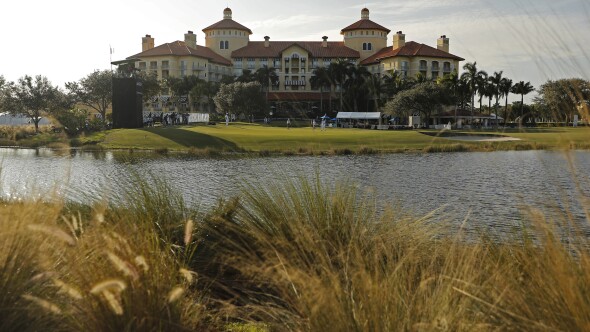If you've teed it up on a public golf course recently, you may have noticed a full parking lot. Markets throughout North America are enjoying surging demand as golfers flock to social-distance-approved fairways while many other time-suckers, from commuting to chauffeuring kids across town, are on hiatus.
What's particularly remarkable to see is that in states or counties where golf operations have been strictly regulated to throttle the number of players on any given day for social distancing, many facilities are nevertheless reporting more rounds booked year-over-year. It's challenging the notion of how many minutes between tee times there really need to be.
The municipal golf courses of Los Angeles, which once had 6-minute tee time intervals prior to 2016, have generally been plagued through the years by similar overcrowding woes as Chicago and New York City's public courses: too much demand, not enough access, and inevitably backed up tee sheets. After L.A. transitioned to 8-minute intervals in 2016 as it enacted its strategic plan, social distancing mandates in the spring of 2020 drove the spacing of the tee sheets at all 12 of their courses up to 12 minutes. Tee times were also now required. No more walk-up play, even at the par-3 courses.
You might think 12 minutes and mandatory advanced reservations would be a surefire formula for a drop in rounds played, right? In a recent interview with Laura Bauernfeind, the manager of the City of Los Angeles' 12 golf courses, seven of which are 18-hole regulation courses,, she confirmed to us recently that since they reopened following COVID-19 stay-at-home orders, they have seen nearly 20% increase in rounds played despite moving their tee time interval from 8 minutes to 12.
"Our first tee time right now is at 5:24 and we have solid reservations right through 6 o'clock at night on all of our golf courses," said Bauernfeind. "It's actually been a really nice break ... Golfers are experiencing some amazing pace of play."
It's worth noting that seven of L.A.'s facilities are regulation 18-hole layouts, while the other five are nine holes or short courses, so they can count more rounds daily at those facilities. And the overall experience is generally better for all involved at this point, which is reflective in recent Golf Advisor reviews of the city courses since they reopened in early May.
Pace of play was great. Tee boxes were mostly level. Fairways were lush and green. This course looks like a country club right now. The greens were medium speed but received shots very well. I highly recommend playing here right now.
Watch: City of L.A.'s Bauernfeind talks increased rounds, improved pace and maintenance in 2020
How does L.A.'s policy compare with its peer big cities? The Chicago Park District finally reopened most of its golf courses on June 8 and tee time intervals at this time are 10 minutes. New York City? Their 14 munis have yet to reopen.
Austin, Texas is the country's 11th largest city and after some touch-and-go with operations in April, settled into a 10-minute interval in May (up from their normal 8 minutes). New data shared by the city reveals their Year-over-Year rounds played in May 2020 at their 18-hole courses Morris Williams, Jimmy Clay, Roy Kizer, and Lions Municipal were all up for the month for an average of 8.2%. Lions already has a reputation as one of the Texas' busiest tee sheets, and yet it did 181 more rounds in the month at 10-minute spacing. (May also had favorable weather, as most rainfall from the month came at night.)
We'd all love fewer players and wide open fairways ahead of us - that's the exclusive, private club dream. But at some point, of course, supply is reduced to the point that a public golf course isn't a viable business, and keeping the books clean is something even non-profit golf enterprises will need to be keenly aware of as government budgets and tax revenues are decimated this year. Some states have had highly onerous regulations on not only tee time spacing (New Jersey was 16 minutes at one point) but group size (Illinois was twosomes only until May 29) and golf cart use (Massachusetts was one of numerous states that was walking-only for a considerable period).
The question is, as restrictions on golf courses are eventually loosened and the sport settles into a more normal rate of demand, what is the incentive for busy public facilities to return to their shorter, 6-8 minute intervals?
For some back-of-the-napkin math, let's consider a popular $40 golf course that has nine hours of "prime" tee times from 7am-4pm (a conservative time frame for getting in 18 holes in four hours during the summer season).
8 minute intervals: 68 tee times (276 golfers) in prime time ($11,040 potential revenue)
10 minute intervals: 56 tee times (224 golfers) in prime time ($8,960 potential revenue)
12 minute intervals: 45 tee times (180 golfers) in prime time ($7,200 potential revenue)
For the 12-minute interval to have the same revenue potential, the tee time would need to be over $61, while the 10-minute interval is just under $50. But if 8 minute intervals aren't 100% utilized, and a worse experience, it may keep golfers from returning as frequently. But management may be better off ignoring the 8-minute revenue potential and understand they may get more happy and repeat customers at 10 or possibly even 12.
Considering the market data we've seen from entities like GolfNow and the National Golf Foundation, courses are booking more tee times than last year and we can assume are often accommodating more golfers daily. Yet there is evidence golfers don't feel as crunched. Here at Golf Advisor, our community's May 2020 Overall Rating (over 18,000 reviews) out of 5.0 was just .02 points lower than in May 2019. May 2020's Pace of Play average rating crept .3 higher.
Golf course staff may learn in 2020 that fewer tee times, possibly at a nominally higher rate, ends up not only filling the tee sheets but leaves a more positive impression on its customers and makes them more likely to return.
























Fact: No one likes slow play and you can only play as fast as the group is front of you. If you see the same people waiting to hit their shot playing behind you, let them play through. Your greens fee doesn't give you the right to hold up play by others on the course.
At our course Fox Hollow intervals are 14 minutes which works out great . We wait for people to off on the second hole which is a par 3 makes for great pace of play . Though we usually catch up on the back nine. If they shorten the interval you risk running out of carts , since everyone has to have their own cart . Leave it like it is .
Most Denver metro area munis are doing at least 10 minutes, and some 15 minutes. So far tee times are being booked up at the earliest allowable booking date and the weather has cooperated for the spring and summer so far.
I think intervals should be no less than 10 minutes and when possible should be 12-15 minutes, and keep this policy moving forward post-pandemic. Also I wish more incentives for walkers would be offered, although I realize carts is major revenue/profit generator.
I play at a club where there are often a groups of 2 some times 3 and of course 4. Occasionally there is a single player. It is customary at our club to allow a group of fewer players behind to play through. How does keeping t-times 12 minutes or more apart compared to 10 minutes protect anyone? When a smaller group catches up and there is an open hole ahead say of a foursome they just step aside and allow the smaller group to play through. That is the polite courteous thing to do. Who wants to chase a group of golfer to the clubhouse when they can go -time permit playing through if so what is the point?
The upscale public course I play in New York has NOT spaced groups out!!!!
Disappointing!!!!
Just played a round with 15 intervals, it was wonderful simply cause there was no delays waiting on the tees. The round moved smoothly through 18 holes, wished more courses would adopt a time between tee times.
The idea that carts speed up a round is ludicrous. people play slow or fast because they socialize . My brothers and I are in our 60's and 70's we walk and when unencumbered play in sub 4 hours. I have played behind 2 people in a cart and had to wait.
It's all in how the cart is used, I agree. If golfers share a cart and have good awareness, it can be faster, but often times they are slower.
8 minutes does not add revenue because it leads to backed up golf courses, frustration and ultimately fewer rounds played
Hello!! Just played on public course in East Tennessee. Really nice course with great fairways and greens. My son and I have been playing for 30 years together. Sunday play at this course is busy, got behind 4-walkers. Really slowed up play, not that I mind walkers, BUT just 2 of us. Not good, we were standing on every tee box. Holding up 4some behind us. Wow, it’s like a change reaction. Probably shouldn’t let a 4some walk on weekends.. Cart only!! There is a huge demand for tee-times now. Good for the revenue stream, BUT it will hurt you when golfers don’t come back, NO one wants to spend 5-6 hours for 18. Something is going to have to give because WE NEED more younger golfers. Am 68, son 37. He is the next gen., golfers to keep HAPPY and innovate ways are the key, keep $$.$$ coming in.. Thanks!!
Did you ask the group in front of you if you could play through, and how much behind the group in front of them were they? I play with a group of walkers at various courses and always encourage a twosome or single in a cart to play through, if there is room ahead.
playing with the bigger interval between tee times has lead to a more relaxed round of golf and a much more enjoyable time. Being an older 4-some, we have some holes that seem to take longer and would cause delay in golfers behind us, but with the longer interval that has not been an issue.
Hope it stays